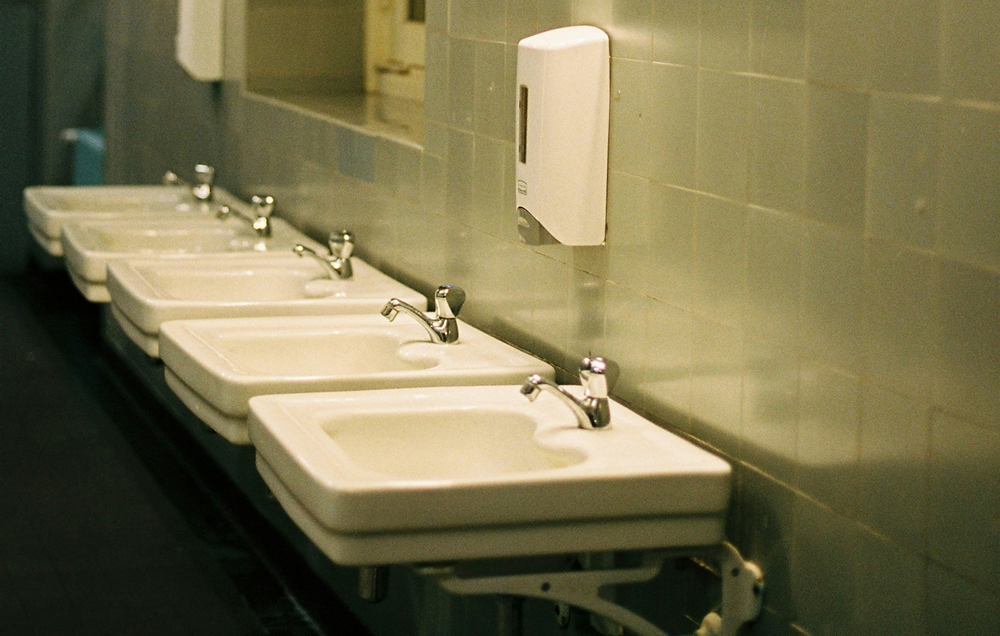Conference and huddle rooms are the most common spaces that we convert to safe rooms. But they aren’t necessarily the best safe room candidates in an office space, depending on the situation. Sometimes, the best corporate safe room option is the humble bathroom.
Bulletproof Bathrooms or Bulletproof Conference Rooms?
While conference rooms typically make for good bulletproof safe rooms, these factors may impact your decision to create a bulletproof bathroom instead:
- Conference rooms usually include a large desk, which reduces the number of people who can shelter there
- Meeting rooms may not be accessible to all building users, either because they’re kept locked or because they’re not fully ADA compliant
- Visitors may not know where conference rooms are located
- Huddle rooms may not be suitable for holding a lot of people for many hours due to lack of water or poor ventilation
- Conference rooms may have large windows that should be replaced with bullet-resistant glass, increasing project costs
If you’re concerned about any of these factors, it’s time to consider a bulletproof bathroom. When our ballistic experts work with companies, we typically suggest creating one safe space per office floor or area where people can go during an emergency. A bathroom usually fits this description—but there are more advantages to creating a bathroom safe room.
The Advantages of Choosing a Bulletproof Bathroom
In addition to being highly accessible, bathrooms are often an existing source of shelter, especially in regions where tornadoes and other extreme weather is commonplace. Bathrooms don’t have windows, are large enough to accommodate many people, and don’t include any exterior walls. There’s only one locking door to replace with a ballistic option. Once you add fiberglass panels, a bathroom safe room is a safe space with an incredible level of fortification and security.
Plus, building-wide ADA compliance ensures these spaces are accessible to all. The running water, full plumbing, and good ventilation make these good spaces for prolonged sheltering in place.
Finally, a bathroom safe room can be extremely low maintenance. Ballistic windows are the component most likely to become inadvertently damaged or to show wear from daily scuffs, UV light, or cleaning products. Fiberglass panels are extremely resilient, so once your bulletproof bathroom project is complete, there’s no additional upkeep you need to worry about.
Essential Bulletproof Bathroom Components
Most of our bathroom to safe room conversions are typically part of confidential security projects, usually retrofits or building-wide renovations. If you can work a bathroom safe room into your initial construction plan, it is even more affordable.
Most bulletproof bathroom safe room projects are secured to UL Level 4 or 5. That means they will stop shots from a high-powered or tactical rifle. They can also withstand prolonged attempts to shoot through the door and walls with a pistol, or other means of forced entry.
We begin a safe room project by adding 1.3” thick ballistic fiberglass panels to the walls. These panels can be installed on top of the existing drywall and drywalled over to conceal the panels. Or, bulletproof fiberglass panels can be installed on the studs, then drywalled over. This
Then, the existing door and frame are replaced with something that can stop bullets. We typically recommend a wood-finish, slab bullet-resistant door, or whatever blends in with the rest of the interior design. Ballistic doors are heavier than their conventional commercial equivalents. To ensure both performance in an emergency and accessibility on a daily basis, we outfit our bullet-resistant doors with ballistically rated frames and continuous hinges. Door hardware is heavy-duty, able to withstand the additional weight as well as repeated blunt force trauma.
Bathroom Safe Room Potential Challenges
In general, installing bulletproof fiberglass wall panels is as easy as hanging drywall. But during a bathroom safe room retrofit, your installers will need to work around maintenance access panels, plumbing, and other fixtures. The panel layout might need to be modified to ensure plumbers and maintenance can continue to access plumbing, electrical runs, and ductwork for repair without compromising ballistic security.
Installers or contractors with limited experience in ballistic barriers could make bathrooms harder to access because bullet-resistant doors are heavy. Experienced companies, like TSS, select hardware and adjust closers so the door operates normally and feels no different than a standard, solid-core, wooden bathroom door.
Outside of installation, the most difficult aspect of any ballistic security project—bulletproof bathrooms included—is compliance. TSS has created dozens of corporate safe rooms over the past several years. In most offices, building the safe room isn’t the hard part; the hard part is making sure you put the protocols and procedures in place so that people know what to do in the event of an emergency. If you’re investing in a bulletproof safe room, we strongly suggest making sure your safety plan is up to date and employees are trained as well.
TSS Is Ready to Help You Improve Workplace Safety with a Bulletproof Bathroom
We have more than 20 years of experience building corporate safe rooms across the country. We can help convert an existing bathroom into a safe place for your team to take shelter. No matter your threat level, company size, or office layout, our experts are ready to help you find a solution that protects your team and fits your budget. To learn more or get started, contact our ballistic security experts today or request a quote.

